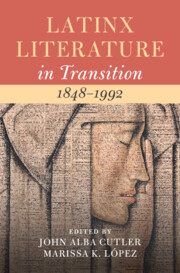Book contents
- Latinx Literature in Transition, 1848–1992
- Latinx literature in transition
- Latinx Literature in Transition, 1848–1992
- Copyright page
- Dedication
- Contents
- Figures
- Contributors
- Acknowledgments
- Introduction
- Part I Space
- Part II Being
- Chapter 5 Brown Modernism from María Cristina Mena to Gloria Anzaldúa
- Chapter 6 The Spanish–Indigenous Binary and Anti-Blackness as Literary Inheritance
- Chapter 7 The Camaraderie of Influence
- Chapter 8 Spiritual Service and Gendered Labor
- Part III Time
- Part IV Form
- Part V Labor
- Bibliography
- Index
- References
Chapter 7 - The Camaraderie of Influence
Intersectional Trauma in Down These Mean Streets
from Part II - Being
Published online by Cambridge University Press: 10 April 2025
- Latinx Literature in Transition, 1848–1992
- Latinx literature in transition
- Latinx Literature in Transition, 1848–1992
- Copyright page
- Dedication
- Contents
- Figures
- Contributors
- Acknowledgments
- Introduction
- Part I Space
- Part II Being
- Chapter 5 Brown Modernism from María Cristina Mena to Gloria Anzaldúa
- Chapter 6 The Spanish–Indigenous Binary and Anti-Blackness as Literary Inheritance
- Chapter 7 The Camaraderie of Influence
- Chapter 8 Spiritual Service and Gendered Labor
- Part III Time
- Part IV Form
- Part V Labor
- Bibliography
- Index
- References
Summary
Just as Song of Solomon and Down These Mean Streets inspired Junot Díaz to become a writer, Youngblood (1954), a novel by the radical African American author John Oliver Killens, inspired Piri Thomas to write Down These Mean Streets (1967). What does Thomas’s personal relationship with Killens reveal about the intertextual relationship between DTMS and Youngblood? What can we learn from reading DTMS as a coming-of-age memoir rather than as a coming-of-age novel? What can be gained by reading DTMS from a child-centered perspective? Inspired by Ralph Ellison’s concept of literary ancestry, Harold Bloom’s theory of the anxiety of influence, Gerard Genette’s definition of intertextuality, and Henry Louis Gates Jr.’s theory of signifying, I argue that the shared themes of racial, sexual, and gendered trauma intertextually bind the homosocial coming-of-age narratives in DTMS and Youngblood. I examine how the coming-of-age narratives in each of these texts explore the entanglement of homosocial camaraderie and ethnic, racial, and sexual identity formation. In critically explicating these themes, this chapter expands Latino American and African American literary history and reveals new insights about the intertextual genealogy of influence between DTMS and Youngblood.
Keywords
- Type
- Chapter
- Information
- Latinx Literature in Transition, 1848–1992 , pp. 126 - 142Publisher: Cambridge University PressPrint publication year: 2025

